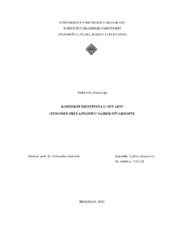| dc.contributor.advisor | Janković, dr Aleksandar | |
| dc.contributor.other | Šuica, dr Nikola | |
| dc.contributor.other | Martinoli, dr Ana | |
| dc.contributor.other | Milovanović, dr Aleksandra | |
| dc.contributor.other | Filipović, dr Aleksandar | |
| dc.creator | Janjetović, Ljubica | |
| dc.date.accessioned | 2020-12-21T12:50:53Z | |
| dc.date.available | 2020-12-21T12:50:53Z | |
| dc.date.issued | 2021-04-02 | |
| dc.date.submitted | 2020-12-21 | |
| dc.identifier.uri | http://eteze.arts.bg.ac.rs/handle/123456789/483 | |
| dc.description.abstract | U ovoj studiji smo se bavili net artom kao segmentom nove medijskotehnološke
kulture kako bismo vidjeli na koji način se ona odnosi prema stvarnosti i
kontekstu identiteta internetskih korisnika i sudionika u toj kulturi. Pod pojmom net art ovdje
smo podrazumijevali oblike savremenih umjetničkih (ali i kulturnih) praksi koje odražavaju
uticaj interneta i tehnologije na društvo i pojedinca, ali tako da na najbolji način odslikavaju
savremenu društveno-tehnološku stvarnost. Metodom studije slučaja, kroz predstavljeni
teorijski okvir i izabrani korpus od četrdeset umjetničkih djela iz domena net arta, preispitane
su specifične osobine konteksta identiteta korisnika. Posmatrali smo ih kroz: odnos fizičkog i
virtuelnog/onlajn okruženja, kroz slojevitost i mogućnost izgradnje višestrukog selfa,
mogućnost auto-re-prezentacije i ostvarenja teleprisustva, autorefleksivnost i varijabilnost,
kao iskustvo spajanja tijela i uređaja te, na kraju, kao umreženo interaktivno djelovanje.
Navedeno istraživanje je pokazalo da je sve što nas okružuje postalo dio stvarnosti koju ne
čine samo fizičko okruženje i prostor tjelesnosti u kojem se krećemo. Stvarnost je proširena
za virtuelnu stvarnost koja je vještačka po prirodi, ali opet stvarna, a prostor u kome
boravimo je postao sajber prostor, ali ne u smislu u kojem ga je shvatio Vilijem Gibson
(William Gibson) – kao prostor u koji korisnici mogu ući kad požele, već kao prostor u kome
se neprestano nalazimo. Zahvaljujući kamerama na ulici, na našim uređajima i u rukama,
postali smo dijelom sajber stvarnosti. Rezultati istraživanja, koje smo interpretirali u okviru
pojma liminalnosti (prelaznosti) Viktora Tarnera (Victor Turner), pokazali su da, kao korisnici
savremene kulture (net arta), postojimo između graničnih stanja novih okruženja. Živeći na
pragu između fizičkog i virtuelnog, između prirodnog i vještačkog, između biologije i
tehnologije, zapali smo u svojevrsnu prelaznu fazu u kojoj smo izgubili stari identitet a novi
još nismo pronašli. | en |
| dc.description.abstract | In this study, we addressed net art as a segment of the new media technology
culture to see how it relates to the reality and context of the identity of Internet users and
participants in that culture. By the term net art here we mean forms of contemporary artistic
(but also cultural) practices that reflect the impact of the Internet and technology on society
and the individual, but in the way they best reflect contemporary socio-technological reality.
Using the case study method, through the presented theoretical framework and selected
corpus of forty works of art from the domain of net art, specific features of the context of user
identity were examined. We observed them through: the relationship between physical and
virtual/online environment, layering and the ability to build multiple self, the ability to selfre-
present and achieve telepresence, self-reflexivity and variability, as an experience of
connecting body and devices and, finally, as a networking. The above research has shown
that everything that surrounds us has become part of a reality that is not only made up of the
physical environment and the body space in which we move. Reality has been augmented for
a virtual reality that is artificial in nature but still real, and the space we live in has become
cyberspace, but not in the sense in which it was understood by William Gibson – as a space
that users can enter whenever they want, but as a space in which we are constantly. Thanks to
cameras on the street, on our devices and in our hands, we have become part of the cyber
reality. The results of the research, which we interpreted within the notion of liminality (a
threshold) of Victor Turner, showed that, as users of contemporary culture (net art), we exist
between the boundary states of new environments. Living on the threshold between the
physical and the virtual, between the natural and the artificial, between biology and
technology, we fell into a kind of transition phase in which we lost our old identity but have
not yet found a new one. | en |
| dc.language.iso | sc | en |
| dc.publisher | Универзитет уметности у Београду, Факултет драмских уметности | sr |
| dc.source | Факултет драмских уметности | sr |
| dc.subject | net art, identitet, liminalnost, sajber kultura, sajber stvarnost | en |
| dc.subject | net art, identity, liminality, cyber culture, cyber reality | en |
| dc.title | KONTEKST IDENTITETA U NET ARTU (FENOMEN PRELAZNOSTI U SAJBER STVARNOSTI) | en |
| dc.title.alternative | THE CONTEXT OF IDENTITY IN NET ART (THE PHENOMENON OF TRANSITION IN CYBER REALITY) | en |
| dc.type | doctoralThesis | en |
| dcterms.abstract | Јанковић, др Aлександар; Шуица, др Никола; Миловановић, др Aлександра; Филиповић, др Aлександар; Мартиноли, др Aна; Јањетовић, Љубица; | |

